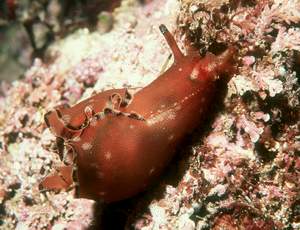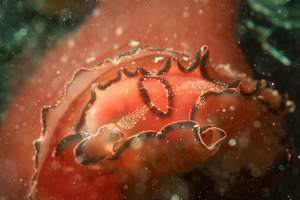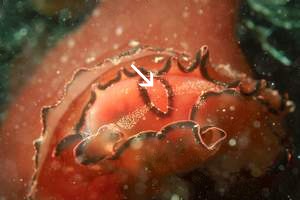Aplysia parvula from Korea
June 28, 2002
From: Dong Bum,Koh


Dear Bill,
Here are two photos of what I think is Aplysia parvula taken on the north coast of Cheju island, Sth Korea.
When I looked closely at the posterior dorsum the animal released a yellowish material. I presume they are mating. Can you tell me about that?
Data: North coast of Cheju island about 6 years ago, 20m depth, Photo: Dong Bum, Koh.
Dong Bum,Koh
drkoh@seasee.co.kr
Koh, D.B., 2002 (Jun 28) Aplysia parvula from Korea. [Message in] Sea Slug Forum. Australian Museum, Sydney. Available from http://www.seaslugforum.net/find/7372
Dear Dong Bum,
This is Aplysia parvula. The black edge to the parapodia are very typical of this species. Another feature of this species is the wide opening on the mantle, also edged in black, through which the shell can be seen. I have marked this with an arrow in the photo alongside. In most species of Aplysia the opening [or foramen] through the mantle to the shell is microscopic and can only be seen as a small papilla. A. punctata is another species with a large foramen like this. In Stephen Hoskins' recent message about A. punctata you can see how the shell can pop out of the mantle, during preservation, when the foramen is so large.
Now to your question about the yellow secretion. I suspect that was either wastes from the kidney or the digestive system. In your lower photo there seem to be a small Aplysia sitting on the mantle of a larger animal. I can't see this clearly but otherwise I can't explain the outer parapodia. If this is so then yes the animals are almost certainly mating. I have seen this behaviour before in A. parvula and in the animal I am calling Aplysia cf. parvula. You will see in my photo of that animal, a smaller one sitting on the shell, between the parapodia, of a larger animal. It stayed there for at least 2 days with its penis inserted in the female aperture of the larger animal. The male organs of many opisthobranchs appear to mature before the female reprodcuctive organs. I suspect that this is the case in these species of Aplysia.
Best wishes,
Bill Rudman
Related messages
-
Aplysia parvula from sthn Queensland
From: Gary Cobb, August 20, 2009 -
Nudibranch? from Bay of Islands, New Zealand
From: Junya Kato, April 3, 2008 -
Aplysia parvula from the Madeira Islands
From: Magno Freitas, February 4, 2008 -
Aplysia parvula in Reunion Island
From: Philibert Bidgrain, February 1, 2007 -
Sea Hare from Indonesia
From: Linda Ianniello, November 23, 2006 -
Hawaiian Aplysia?
From: Sean Kearney, July 20, 2006 -
Aplysia parvula from sthn Queensland
From: Bruce Wilkie, February 10, 2006 -
Please identify this Sea Hare
From: Eileen Baker, February 2, 2006 -
Re: Aplysia parvula - color forms?
From: Asther M. Lau, January 24, 2006 -
Re: More on Aplysia parvula color forms
From: Asther M. Lau, January 24, 2006 -
Aplysia parvula from eastern Russia
From: Alexei Chernyshev , January 12, 2006 -
Aplysia parvula from Halmahera, Indonesia
From: Richard Harlan, June 9, 2005 -
Aplysia parvula laying eggs
From: Dong Bum Koh, May 26, 2005 -
Re: Aplysia parvula - eaten by Nemertine worm
From: Jon Norenburg, May 3, 2005 -
Aplysia parvula - eaten by Nemertine worm [1]
From: Dong Bum Koh, April 29, 2005 -
Aplysia parvula - eaten by Nemertine worm [2]
From: Dong Bum Koh, April 29, 2005 -
Aplysia parvula from Fethiye Bay, Turkey
From: Ant Turkmen, July 15, 2004 -
Aplysia parvula from South Australia
From: Carol van der Pennen, January 15, 2004 -
Colour variation in Aplysia parvula
From: Marina Poddubetskaia, December 16, 2003 -
Food of Aplysia parvula in Mayotte
From: Marina Poddubetskaia, December 16, 2003 -
Re: Other Aplysia parvula from Senegal
From: Marina Poddubetskaia, July 17, 2003 -
Re: Aplysia parvula from Outer Hebrides
From: Jun Imamoto, July 11, 2003 -
Other Aplysia parvula from Senegal
From: Marina Poddubetskaia, July 8, 2003 -
Aplysia parvula from Senegal
From: Marina & Patrice, April 29, 2003 -
Aplysia parvula from Outer Hebrides, Scotland
From: Bill Rudman, April 29, 2003 -
Aplysia parvula from California
From: Bruce Wight, July 29, 2002 -
Mediterranean Aplysia parvula - dwarf male?
From: Marina Poddubetskaia, July 18, 2002 -
More on Aplysia parvula color forms
From: Cory Pittman, July 16, 2002 -
Aplysia parvula - color forms?
From: Scott Johnson, July 9, 2002 -
Aplysia parvula from the Bahamas
From: Anne DuPont, June 8, 2002 -
Re: Aplysia parvula from Bahia de Banderas
From: Alicia Hermosillo, May 9, 2002 -
Aplysia parvula from Bahia de Banderas
From: Alicia Hermosillo, May 6, 2002 -
Aplysia parvula from Sth Africa
From: Valda Fraser, August 9, 2001 -
Re: Juvenile Sea Hare
From: Juan Lucas Cervera, May 18, 2001 -
Juvenile Sea Hare
From: A. Fahrner & M. Schrödl, May 14, 2001 -
Aplysia parvula from Sulawesi
From: Lindsay Warren, August 5, 2000 -
Aplysia punctata or A. parvula?
From: Erwin Koehler, October 18, 1999
